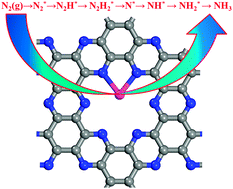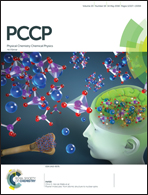Computational screening of a single transition metal atom supported on the C2N monolayer for electrochemical ammonia synthesis†
Abstract
The nitrogen reduction reaction (NRR) under ambient conditions using renewable energy is a green and sustainable strategy for the synthesis of NH3, which is one of the most important chemicals and carbon-free carriers. Thus, the search for low-cost, highly efficient, and stable NRR electrocatalysts is critical to achieve this goal. Herein, using comprehensive density functional theory (DFT) computations, we design a new class of NRR electrocatalysts based on a single transition metal (TM) atom supported on the experimentally feasible two-dimensional C2N monolayer (TM@C2N). Based on the computed free energies of each elementary pathway, Mo@C2N is predicted to exhibit the best catalytic activity among the TM@C2N, in which the proton-coupled electron transfer of the NH2* species to NH3(g) is the potential-determining step. Especially, the computed onset potential of the NRR on Mo@C2N is −0.17 V, which is even lower than that for the well-established stepped Ru(0001) surface (−0.43 V). Furthermore, the NRR catalytic performance of these TM@C2N can be well explained by their adsorption strength with N2H* species. Our findings open a new avenue for optimizing the TM catalytic performance for the NRR with the lowest number of metal atoms on porous low-dimensional materials.



 Please wait while we load your content...
Please wait while we load your content...